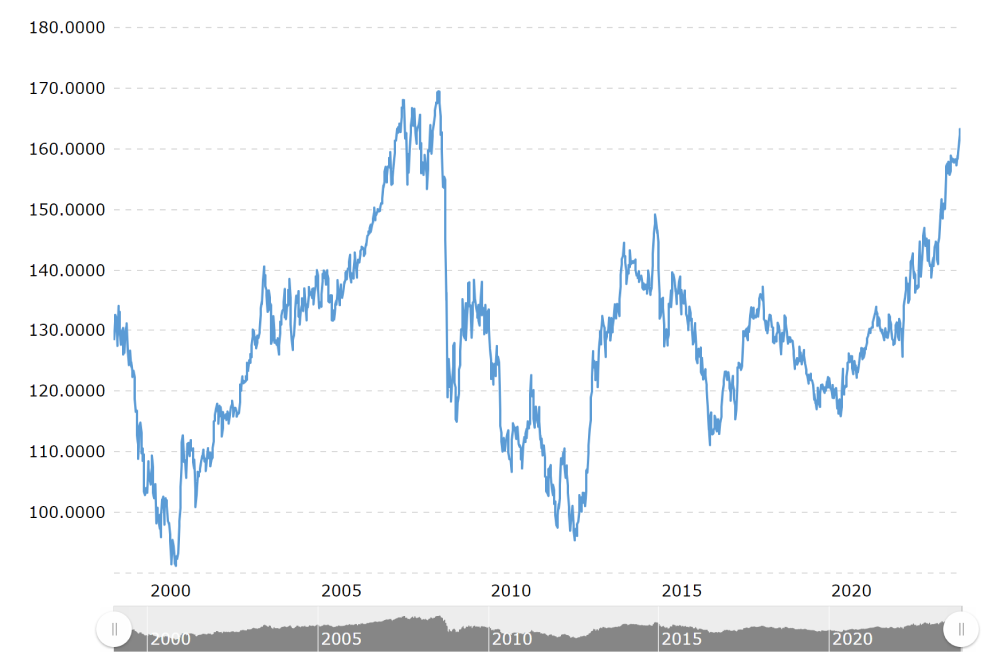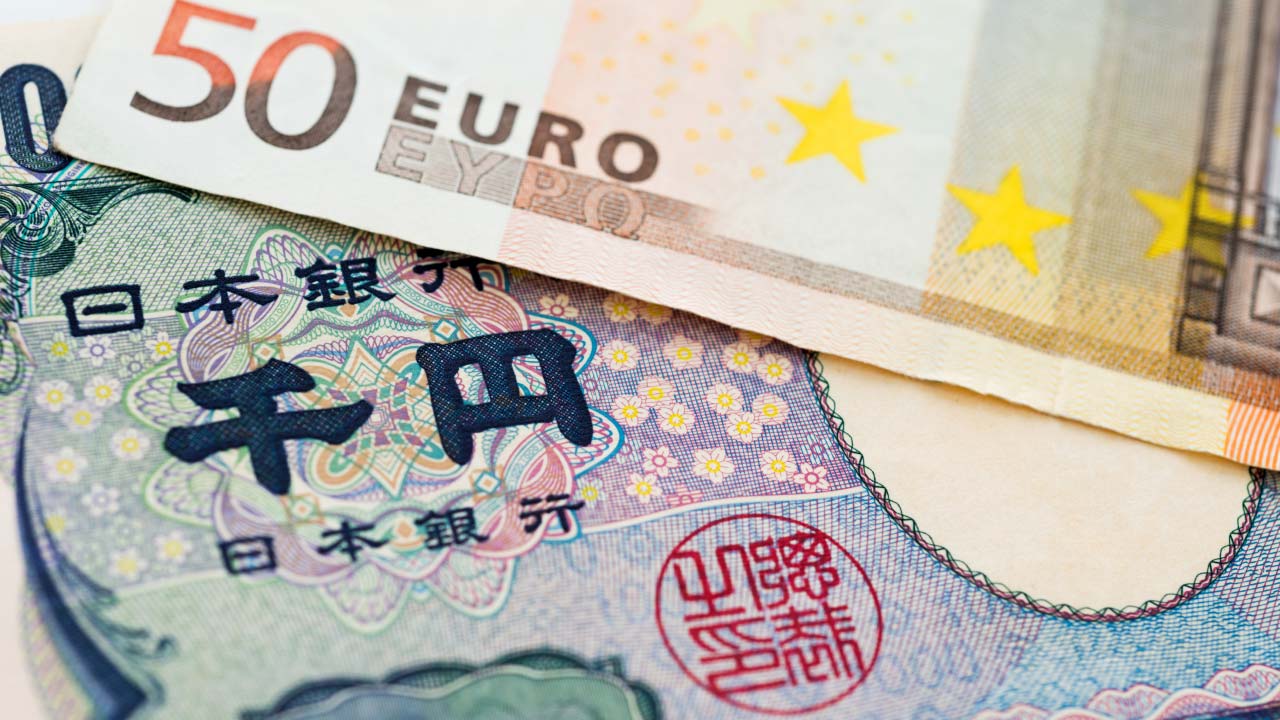EUR/JPY touched its 15-year high in August 2023 by trading near 159.76 and rising even higher as the new year began, touching 164.187. Throughout the past year, the forex pair has moved consistently.
In this article, we look at the popular EUR/JPY trading strategies.
History of EUR/JPY
In the last five years, EUR/JPY, the currency pair, has consistently increased by over 3%, with the largest jump in 2023 from 2022, recording a 15.38% annual positive change. The lowest price EUR/JPY touched in the last five years was in 2020 (114.51), and the highest was in 2023 (164.11). Over all these years, historically, the pair has performed consistently well and witnessed positive changes only, except in 2019, where it dipped by 3.14%.
Past performance is not a reliable indicator of future performance.

Advantages of trading EUR/JPY
- Cross-currency pair: EUR/JPY is a cross-currency pair representing the Euro against the Japanese Yen. This diversification allows traders to gain from movements in both European and Asian economies, offering a broader market exposure.
- Diverse trading hours: Traders can capitalize on liquidity throughout the day, as markets in Europe and Asia overlap, providing ample opportunities for timely entries and exits.
- Interest rate differentials: Interest rate differentials between the Eurozone and Japan contribute to potential gain opportunities. Variances in monetary policies impact the carry trade strategy, where traders may earn or pay interest differentials for holding positions overnight.
- Fundamental analysis opportunities: The EUR/JPY pair offers rich fundamental analysis opportunities. Traders can leverage economic indicators, central bank policies, and geopolitical events in both the Eurozone and Japan for informed decision-making, enhancing the depth of strategic analysis for potential trades.
Risks of trading EUR/JPY
- Correlation risks: EUR/JPY may exhibit a correlation with other currency pairs, potentially leading to increased risk during market turbulence. Traders should be wary of interconnected movements, as events impacting the Euro or Yen can influence multiple pairs simultaneously.
- Carry trade dynamics: The carry trade strategy, common in currency markets, involves borrowing a low-interest currency to invest in a higher-yielding one. However, fluctuations in interest rates and market sentiment can expose traders to significant risk, especially if interest differentials change abruptly.
- Currency corridor risks: Some central banks implement currency corridors or intervention policies to stabilize exchange rates. Traders in EUR/JPY should be cautious of sudden policy shifts, as interventions can lead to unexpected and sharp price movements, impacting trading strategies.
- Geopolitical events: Geopolitical events can influence the EUR/JPY pair, given the Eurozone and Japan's global economic roles. Political instability, trade tensions, or unforeseen events can trigger market volatility, potentially resulting in rapid and unpredictable currency fluctuations. Traders should stay informed about geopolitical developments to manage associated risks effectively.
Tips to trade EUR/JPY effectively
Consider timezone awareness
Given the Eurozone and Japan's geographical locations, traders should consider the overlapping trading hours between European and Asian markets. The European trading session typically starts at 8:00 AM GMT, with major financial centers like London becoming active. The Asian session begins shortly after, with Tokyo being a key player. The overlap occurs during the late Asian and early European sessions (around 12:00 AM to 3:00 AM GMT). Optimal trade execution often occurs during these periods, capitalizing on increased liquidity and potential price movements specific to the EUR/JPY pair.
Incorporate Yen sensitivity
Recognize the Japanese Yen's sensitivity to risk sentiment. As a less risky currency, the JPY often strengthens during market uncertainties. Traders should monitor global risk factors and adapt strategies accordingly, acknowledging the Yen's role in influencing the EUR/JPY pair's directional movements.
Monitor Eurozone economic indicators
Stay attuned to economic indicators from the Eurozone, such as GDP growth, inflation rates, and employment data. The performance of the Euro is closely tied to these factors, impacting the EUR/JPY pair. Informed analysis of Eurozone economic health enhances precision in predicting potential price fluctuations in the currency pair.
How to trade EUR/JPY?
1- Analyze market conditions
Assess the overall market sentiment and economic conditions specific to the Eurozone and Japan. Consider economic indicators, political stability, and trade dynamics affecting the EUR/JPY pair.
2- Conduct technical and fundamental analysis
Utilize both technical indicators and fundamental analysis tailored to EUR/JPY. Study price charts and support/resistance levels and incorporate economic data from the Eurozone and Japan to make well-informed trading decisions.
3- Select a trading timeframe
Choose a timeframe aligned with the unique characteristics of the EUR/JPY pair. Consider factors such as volatility and liquidity during specific trading sessions, ensuring the chosen timeframe suits the pair's dynamics.
4- Confirm entry signals
Validate entry signals using indicators and patterns relevant to EUR/JPY. Confirm directional signals with a comprehensive understanding of market conditions and the specific factors influencing the Euro and Yen.
5- Set stop-loss levels
Determine stop-loss levels based on the pair's historical price movements, volatility, and risk tolerance. Adjust levels considering key support/resistance zones and market-specific risk factors.
6- Consider risk-reward ratio
Evaluate the risk-reward ratio in the context of EUR/JPY's unique characteristics. Factor in potential volatility and market conditions to ensure a balanced approach to risk management.
7- Monitor economic calendar
Stay updated on economic releases from both the Eurozone and Japan. Key indicators, interest rate decisions, and geopolitical events can significantly impact EUR/JPY, influencing trading decisions.
8- Regularly review and analyze trades
Periodically review and analyze past trades in the context of EUR/JPY's performance. Learn from successes and setbacks, refining the strategy based on the pair's specific behavior.
Placing trades in EUR/JPY
Traders can navigate EUR/JPY's liquidity and volatility, capitalizing on their strategic engagement to gain from global economic developments and currency dynamics in this significant forex market pairing. While trading EUR/JPY presents lucrative prospects during key market hours, prudent investors must also remain cautious of associated risks.
Disclaimer: All material published on our website is intended for informational purposes only and should not be considered personal advice or recommendation. As margin FX/CFDs are highly leveraged products, your gains and losses are magnified, and you could lose substantially more than your initial deposit. Investing in margin FX/CFDs does not give you any entitlements or rights to the underlying assets (e.g. the right to receive dividend payments). CFDs carry a high risk of investment loss.




